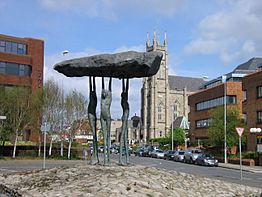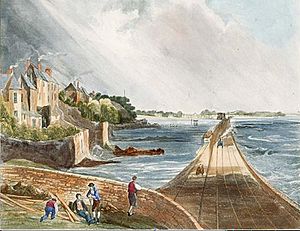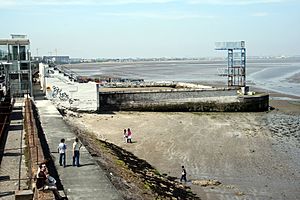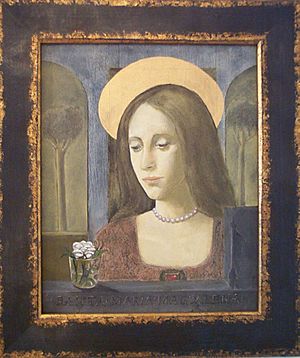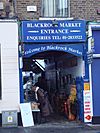Blackrock, Dublin facts for kids
Quick facts for kids
Blackrock
An Charraig Dhubh
|
|
|---|---|
|
Suburb (village core)
|
|
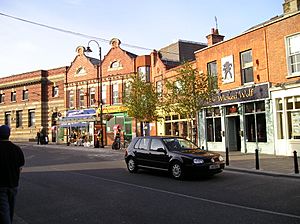
Blackrock street scene
|
|
| Country | Ireland |
| Province | Leinster |
| County | County Dublin |
| County Council | Dún Laoghaire–Rathdown |
| Highest elevation | 80 m (260 ft) |
| Lowest elevation | 0 m (0 ft) |
| Population
(2006)
|
|
| • Urban | 28,070 |
| Eircode (Routing Key) |
A94
|
| Dialing code | 01 (+3531) |
| Irish Grid Reference | O211296 |
Blackrock (Irish: An Charraig Dhubh) is a suburb of Dublin, Ireland, 3 km (1.9 mi) northwest of Dún Laoghaire.
Contents
Location and access
Blackrock covers a large but not precisely defined area, rising from sea level on the coast to 90 metres (300 ft) at White's Cross on the N11 national primary road. Blackrock is bordered by Booterstown, Mount Merrion, Stillorgan, Foxrock, Deansgrange and Monkstown. The area has a range of industries, notably in the IT and service areas.
Transport
Blackrock has a station on the Dublin Area Rapid Transit (DART) line, which is 15 minutes away by train from the city centre. The DART runs on the same track that was built in 1834 for the Dublin-Kingstown railway. Blackrock railway station, on both the DART and the mainline Dublin-Wexford railway, opened on 17 December 1834.
Dublin Bus also serves the area with multiple bus routes. These are routes 4, 7, 7a, 17, 46e, 84/a and 114.
The Aircoach services to Dublin Airport from Dalkey and Greystones call at Blackrock en route to the airport.
The Blackrock bypass was built in the late 1980s and officially opened by Councillor Anne Brady on 24 March 1988. The bypass is part of the N31 which joins the harbour at Dún Laoghaire to the national Primary Route network.
History
Blackrock was historically a small fishing village, which began to be developed only in the 19th century, although a settlement at the same location from medieval times is well attested to.
Origin of the name
Blackrock, some hundreds of years ago was variously called Newtown-at-the Black Rock, Newtown on the Strand by the Black Rock, Newtown Castle Byrne, or simply Newtown, so that "Blackrock" is simply an abbreviation of one of its ancient titles. For example, the town was called Newtown in a 1488 Act of Parliament The name still survives in Newtown Avenue, and Newtown House. It was thus distinguished from Newtown-in-the-Deer-Park, as the village of Newtown Park was then called, from the circumstance that it was built in the Deer Park belonging to Stillorgan House, or Castle (a quo Newtownpark Avenue).
Blackrock is named after the local geological rock formation to be found in the area of Blackrock Park. Most of it is now buried under the park, but it is said that it is possible to see it just north of the pond. The rock itself is a limestone calp that when wet appears black, this giving the name Black Rock. For the construction of the railway in 1834, the rock was extensively used for the wall cappings between Williamstown and Blackrock and can also be seen in the walls of the train station at Blackrock. Interestingly, St. Marys Chapel of Ease on St. Mary's Place, nicknamed the Black Church, is constructed using the same Black Rock (limestone calp), although the rock used in its construction is locally sourced to the church.
The Rock Road
The Rock Road, which forms the south western boundary of the park, is said to form part of one of the oldest roads in the country, having been part of the ancient Slíghe Chualann constructed by the High King of Ireland several centuries before St. Patrick, to connect Tara with what is now southern Dublin and north-east Wicklow. The road may have facilitated the O'Toole and the O'Byrne clans in their raids on the neighbourhood of Dublin.
In 1787, the Blackrock road was such a common place for highway robberies that, in an attempt to put an end to these crimes, a local meeting was held at Jennett's Tavern in Blackrock and chaired by the then Lord Viscount Ranelagh. The meeting concluded when one of the outcomes was "Resolved, That we will give a reward of £20 to any person who will apprehend and prosecute to conviction any person guilty of a robbery upon the Blackrock-road, from Dublin to Dunleary, Bullock, Dalkey, Rochestown, Cabinteely, and Loughlinstown".
Blackrock Park
Blackrock had a beach that was a popular bathing place until the construction of the railway close to the shoreline. The space between the shore and the railway created an area that flooded with sea water at high tide. This created a malodorous salty marsh similar to that at Booterstown marsh. This marsh was a cause of local discomfort for years until it was decided by the Blackrock Town Commissioners (established in 1860) to fill the area in and create a park. The park, which stretches from Blackrock to Booterstown (encompassing Williamstown), was created in the early 1870s. The granite gates at the main entrance once belonged to a house called Vauxhall. The gardens at the entrance were part of the gardens of the old house.
The Williamstown Martello Tower in Blackrock Park was built between 1804–1806. When the tower was built, it would have been surrounded by sea water at high tide as it was built in the inter-tidal beach area. The tower became isolated from the sea when the construction of the railway took place, but sea water still flowed into the area at high tide. It wasn't until the filling in of the area to form the Blackrock Park that the tower was to be on dry land. That part of the tower which is visible today is actually the first floor as the ground floor is buried underground.
In 2007, Dún Laoghaire-Rathdown County Council published plans for the conservation and development of the park. The plans include extensive redevelopment of the course of the Priory River, as well as refurbishment of several of the buildings within the park. As of 2013, no work has been carried out as part of the redevelopment masterplan, with no start date published.
Blackrock Baths
The Blackrock baths were provided for by the railway company in 1839 and were built beside the Blackrock train station. A special train ticket also permitted entrance to the baths. In 1887, the baths were rebuilt in concrete with a large gentlemen's bath and a smaller ladies' bath. In 1928, the Urban District Council bought the baths for £2,000 and readied them for the Tailteann Games. The baths, with a 50-metre pool, were well known for their swimming galas and water polo and could accommodate up to 1,000 spectators.
Eddie Heron lived in Sandycove and is known for his achievement as 36 years undefeated Springboard and Highboard Diving Champion of Ireland. A plaque commemorating him is on the railway bridge that crosses over to the baths.
On 11 September 1891, Thomas Joseph Crean, while swimming with fellow students near Blackrock, helped rescue a 21-year-old art student named William Ahern. Crean noticed that Ahern was in trouble and together with a young solicitor named Leachman from Dundrum, he managed to bring him ashore. For his bravery he was awarded a medal by the Royal Humane Society.
The decline in use of the baths started in the 1960s when indoor heated swimming pools started to appear. Dún Laoghaire Corporation closed the Blackrock Baths in the late 1980s and by 1992, due to lack of maintenance, parts of the baths were dismantled. They have since been sold to developers Treasury Holdings. In 2013, the baths were demolished due to safety concerns following a routine inspection by Dún Laoghaire-Rathdown County Council. It was found that the diving platform had been significantly corroded and detached from the pool base.
Historic houses
Many fine houses of historical and architectural significance were built in the area, some of which are still existing today, while others have been demolished.
Frescati House, built in 1739, was a fine example and was at one time the childhood home of Lord Edward FitzGerald. Frescati, despite much local protest to save it, was demolished in 1983 and Frascati Shopping Centre now stands in its place.
Maretimo House was built in 1770 as a summer residence for Nicholas Lawless, 1st Lord Cloncurry, who had his main house in Lyons, County Kildare. His son Valentine Lawless, 2nd Baron Cloncurry gave land beside the house for the building of the Roman Catholic Church, St. John the Baptist. At the time of the construction of the Dublin and Kingstown Railway, Lord Cloncurry was compensated with, among other things, a private railway bridge and harbour. Maretimo house was demolished in 1970 and apartments of the same name now stand in its place. The private railway bridge can still be seen today, but is not maintained and its once elegant walkway has been replaced by a corrugated iron walkway.
Blackrock House, built in 1774 by Sir John Lees (1737–1811), is one of a few 18th-century houses built with red brick. It has some fine features such as a two-storey red brick porch. It also features a large coach-house, stable yard and gate-lodge. With the construction of the railway Lees was also compensated with a tunnel being built through his land. There is a ruin of a small summer-house near Lord Cloncurry's harbour. The house is still here to be seen today, although it is currently divided into flats.
Rosefield (previously Belleville) was demolished in 1983 to make way for the Blackrock Clinic. Rosefield was one of the first seaside villas built on the Fitzwilliam estate around 1750.
Talbot Lodge was an 18th-century villa that was later doubled in size. It was bought by the Sisters of Charity and became part of the Linden Convalescent Home. It was sold to developers and was demolished in December 1989.
Religion in history
The Church of Ireland built two churches in the area. The Booterstown parish was established in 1821 from the Donnybrook parish and the first church built was St. Philip and St. James Church in 1822 on Cross Avenue. To follow was All Saints Church on Carysfort Avenue in 1868.
The Catholic Daughters of Charity of Saint Vincent de Paul founded St. Catherine's Seminary in 1939 with the purchase of the house Dunardagh, Temple Hill.
The Catholic Dominican Order came to Blackrock in the 1830s with the purchase of the house Sion Hill on the corner of Mount Merrion Avenue and Cross Avenue. They set up Sion Hill Convent, a girls' school called Dominican College Sion Hill, and Froebel College of Education. They also run an Adult Education Centre and they ran St. Catherine's College of Education for Home Economics between 1929 and 2007.
The Catholic Holy Ghost Fathers came to Blackrock from Paris and established Blackrock College in 1860 with the purchase of Castle Dawson. They later bought Williamstown Castle in 1875, Clareville in 1899 and Willow Park in 1924. All of these buildings, except Clareville, are still standing today and form Blackrock College and Willow Park School.
The Kellyite sect was formed by Rev. Thomas Kelly (1769–1854), who broke away from the Church of Ireland. He built a church called Christchurch on Carysfort Avenue. The sect did not last long and in 1872 the church was handed over to the Church of Ireland. In the early 1960s the church was demolished as it was surplus to needs. The old church was located where the car park is on the corner of Carysfort Avenue and the Blackrock Bypass.
The Methodist congregation established a church on George's Avenue in the 19th century. The church is still standing but disused. The congregation moved to a new church beside the town hall on Newtown Avenue. The congregation consolidated with that of Dún Laoghaire around the middle of the 20th century. Since then the Blackrock building is used as a community meeting place called Urban Junction.
The Catholic Order of St. Camillus have a community residing at South Hill Avenue while Opus Dei established Rosemont secondary school off Temple Hill around 1970.
The Presbyterian (Church of Ireland) congregation established their Blackrock parish in 1895 and met in the Blackrock Town Hall until they built St. Andrew's Church on Mount Merrion Avenue in 1899.
The Catholic Religious Sisters of Charity arrived in 1864 with the purchase of Linden and established Linden Convalescent Home. They later bought Talbot Lodge which became part of the convalescent home. The home was sold in the late 1990s to developers who built the Linden residential complex. More recently, in 2003, the congregation expanded Our Lady's Hospice to Blackrock with the opening of The Venerable Louis and Zelie Martin Hospice.
The Roman Catholic parish of Blackrock was established from Booterstown in 1922. The first church in the area was built on Sweetman's Avenue in 1823. In 1845 a much larger church, St. John the Baptist was constructed on Temple Hill. Another church was built in 1967 on Newtownpark Avenue called the Church of the Guardian Angels.
The Society of Friends (Quakers) have their Dublin burial grounds, Friends Burial Ground, at Temple Hill. Their meeting house is on Carrickbrennan Road, Monkstown.
Blackrock today
Features
Blackrock Clinic, a private clinic in Williamstown, was built on the site of Rosefield House.
The town hall was completed in 1865 while the Carnegie Library and the Technical Institute were built in 1905. The site for the Technical Institute was presented to the Town Commissioners by a resident, William Field MP, in 1898.
Commerce
Blackrock is a large commercial centre with cafes, restaurants, boutiques, hairdressers and barbers, a tattoo and piercing studio, pharmacies, supermarkets, art galleries, antiques and home improvements outlets as well as barssuch as The Breffni, Jack O'Rourkes, O'Donohues, Sheehans, Conways and The Wicked Wolf.
The Blackrock Shopping Centre was built in 1984 by Superquinn who manage the development and are the anchor store.
There are many high street finance branches for AIB, Bank of Ireland, EBS, National Irish Bank, Ulster Bank and the Blackrock Credit Union. Permanent TSB closed their Blackrock branch in March 2010 but retain their administrative offices on Carysfort Avenue.
There are many office buildings that house large corporations such as Canada Life Financial, Zurich Financial Services and AIG. Also car delaers such as Carroll & Kinsella Motors, Maxwell Motors (generally BMW) and Eco Aer (eco electric vehicles).
The Blackrock Market was set up in 1996 just off Main Street and has a range of independent sellers who sell all sorts of items like bean bags, candles, stamps and coins, second hand books and antiques. There are also food sellers of crepes, cakes and ethnic food. The market is open Saturday and Sunday, but some stalls open during the week also.
In April 2010, a new business organisation for the area was formed. It is known as the Blackrock Business Network. In Spring 2011, a new website "I Love Blackrock" was launched. and promotes over 400 businesses in the area.
Education
Primary schools
For a more comprehensive list of schools in Blackrock and its hinterland, see the link below (Primary Schools in South County Dublin).
- Benincasa, Mount Merrion Avenue (Roman Catholic)
- Carysfort National School, Convent Road (Roman Catholic)
- Guardian Angels, Newtownpark Avenue (Roman Catholic)
- Willow Park, Rock Road (Roman Catholic)
- St. Augustine's, Obelisk Park (Roman Catholic)
- All Saints, Carysfort Avenue (Church of Ireland)
- Booterstown National School, Cross Avenue (Church of Ireland)
- Our Lady of Mercy National School, Rosemount Avenue (Roman Catholic)
Secondary schools
- Blackrock College, Rock Road (Roman Catholic)
- Dominican College Sion Hill, Cross Avenue (Roman Catholic)
- Newpark Comprehensive School, Newtownpark Avenue (Church of Ireland)
- Newpark Music School, Newtownpark Avenue
- Rosemont Secondary School, Temple Road (Roman Catholic)
- St. Andrew's College, Booterstown Avenue (Inter-Denominational)
Third level
- Carysfort College was a large teacher training college in the area until its closure in 1988.
- Froebel College of Education, Cross Avenue is one of the 5 major Teacher Training Colleges in Ireland. (Moved to NUI Maynooth campus in 2013)
- Michael Smurfit Graduate School of Business is a business school of UCD that occupy the old buildings of Carysfort College.
- Newpark Music Jazz School, Newtownpark Avenue
- Progressive College, Carysfort Avenue and UCD Blackrock Campus, specialises in the provision of a range of childcare and healthcare courses.
- Construction of the new Blackrock Institute of Further Education will finalized in early 2012. This college will be located in the centre of Blackrock following a re-location of Senior College Dun Laoghaire
Churches
- All Saints, Carysfort Avenue (Church of Ireland)
- Church of the Guardian Angels, Newtownpark Avenue (Roman Catholic)
- St. Andrew's, Mount Merrion Avenue (Presbyterian)
- St. John the Baptist, Blackrock (Roman Catholic)
- St. Philip and St. James, Cross Avenue, (Church of Ireland)
People
Lord Edward FitzGerald (1763–1798) was born and lived in Frescati House for a part of his life. He was an Irish aristocrat and revolutionary and was one of the commanders in the Irish Rebellion of 1798.
Valentine Lawless (1773–1853) the second Baron Cloncurry, was an Irish politician and landowner that had a summer residence in Blackrock called Maretimo. He is reputed to have played a part in the Irish Rebellion of 1798 and 1803.
Patrick Byrne (1783–1864) lived at 3 Waltham Terrace from 1855. He was an architect who built many Catholic churches in Dublin including the local Catholic parish church, St. John the Baptist. He also served as a vice president of the Royal Institute of the Architects of Ireland.
James Stephens (1825–1901) at one time lived at 82 George's Avenue, Blackrock and was a founding member of the Irish Republican Brotherhood.
Charles Kickham (1828–1882) lived at James O'Connors former house of 2 Montpelier Place, off Temple Hill. He was a novelist, poet, journalist and one of the most prominent members of the Irish Republican Brotherhood.
Lieutenant General Harry Hammon Lyster (1830–1922) was born in Blackrock and was an Anglo-Irish recipient of the Victoria Cross, the highest and most prestigious award for gallantry in the face of the enemy that can be awarded to British and Commonwealth forces.
William Edward Hartpole Lecky (1838–1903) was an Irish historian and publicist born in Newtown Park. He is noted for his chief work of A History of England during the Eighteenth Century.
John Boyd Dunlop (1840–1921) lived in a large 18th-century house called South Hill and developed the first practical pneumatic or inflatable tyre. He was one of the founders of the rubber company that bore his name, Dunlop Pneumatic Tyre Company.
Sir William Orpen (1878–1931) lived in a house called Oriel on Grove Avenue, just off Mount Merrion Avenue. He was a portrait painter and official war artist in the First World War. Some of his work is permanently on display in the National Gallery of Ireland.
Maurice Walsh (1879–1964) lived on both Stillorgan Park Avenue and Avoca Road in Blackrock. He is noted as a novelist and best known for his short story The Quiet Man.
Éamon de Valera (1882–1975) lived in a few houses in the area including Bellevue on Cross Avenue 1933–1940. He was educated at Blackrock College and later taught there and at Our Lady of Mercy College, Carysfort. He retired to Linden Convalescent Home after his Presidential term ended and on 29 August 1975 and died there.
The writer James Joyce (1882–1941) lived in 23 Carysfort Avenue known as Leoville for one year in the early 1890s. This house is still extant. In his book A Portrait of the Artist as a Young Man he makes reference to the local parish church St. John the Baptist.
Kevin O'Higgins (1892–1927) rented Lisaniskea ("Lios na Uisce"), near Blackrock, in 1923–1925. He later moved to Dunamase on Cross Avenue and was the Minister for Justice in the Government of The Irish Free State. He was assassinated on the Booterstown end of Cross Avenue on his way to Mass at his local parish church on 10 July 1927 by members of the IRA. It is believed that he was assassinated for ordering the execution of many republicans, including Rory O'Connor (Irish republican). Rory O'Connor was Kevin's best man at his wedding in 1921.
Brian O'Nolan (1911–1966) lived at 4 Avoca Terrace and later at 81 Merrion Avenue. He was an Irish novelist and satirist, best known for his novels At Swim-Two-Birds and The Third Policeman written under the nom de plume Flann O'Brien.
The abstract painter Cecil King (1921–1986) lived for many years on Idrone Terrace, and one of his paintings is entitled Idrone.
The artist Sean O'Sullivan, (1906–1964) lived for many years in Avoca Avenue. He painted many notable people including the President of Ireland, Éamon de Valera.
The portrait painter Reginald Gray was born in Blackrock in 1930. He lived for twenty-seven years at 10 Avoca Place and was a near neighbour of the artist Seán O'Sullivan. He lived most of his life in France. He is an elected member of The American Society of Portrait Artists.
Rowan Gillespie is an Irish bronze casting sculptor of international renown, who created the "Blackrock Dolmen" sculpture in Blackrock. He works out of Blackrock with a purpose built bronze casting foundry in a house called Clonlea.
Ryan Tubridy was born in Blackrock in 1973 and went to Blackrock College. He is an RTÉ presenter of radio and television shows and the current host of the long-running chat show The Late Late Show.
Eoin Dillon, Uilleann piper, of Kila, was brought up in the Blackrock area and lived on Idrone Terrace. Living in Blackrock influenced many of his contemporary tunes.
Actor Frank Kelly, best known for playing Father Jack on the television comedy series Father Ted, was born and lived for most of his life in Blackrock.
Travel writer and hospital founder Sarah Maud Heckford (1839-1903), was born in Blackrock.
Gallery
Images for kids




